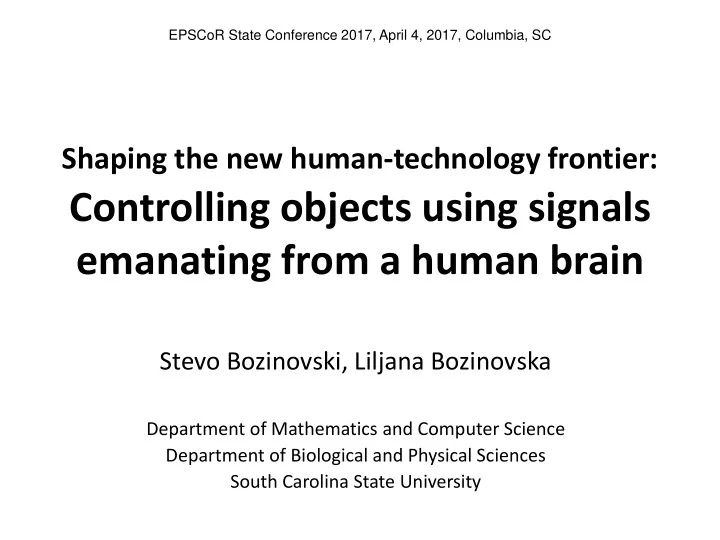

EPSCoR State Conference 2017, April 4, 2017, Columbia, SC Shaping the new human-technology frontier: Controlling objects using signals emanating from a human brain Stevo Bozinovski, Liljana Bozinovska Department of Mathematics and Computer Science Department of Biological and Physical Sciences South Carolina State University
Overview • Psychokinesis challenge • Idea of EEG based psychokinesis • Pioneering result, 1988 • Other results in 20 th century • Application of Brain-Computer Interface in 21 st century • EPSCoR support of the SCSU BCI group • Current engagement of SCSU BCI group
Introduction: The challenge of psychokinesis • It was an old dream of people to move physical objects using energy emanating from human brain. It science fiction literature it was named psychokinesis.
Idea: EEG-based psychokinesis • Observation 1987: EEG is measured on the scalp and electromagnetic energy is generated by the brain: So EEG is representation of electromagnetic energy generated by the brain. Is EEG-based psychokinesis possible? electrode brain
Conceptual design EEG control signal electrode brain Physical object with own energy for mechanical movement
Experimental proof of the concept, 1988
20 th century achievements • 1988, Pioneering achievement, in Macedonia, (Bozinovski, Sestakov, Bozinovska): Energy emanating from human brain, non invasively • 1999, second control of a physical object, in North Carolina (Chapin, Moxon, Markowitz, Nicolelis): Energy measured inside brain of an animal, a rat, invasively • In 20 th century there was no other result in controlling physical objects using energy generated by the human brain
Brain-Computer Interface • Brain computer interface is a way of controlling both virtual objects on computer screen and physical objects, using biosignals
Applications of Brain-Computer Interface • In 21 st century there are thousands of reports about using brain and other signals to control both virtual objects on the screen and physical objects
Application of brain computer interface • Writing a text on a computer screen • Moving a visual object on a computer screen • Moving a physical object – A robot – A wheelchair – A prosthesis
EPSCoR support for the SCSU brain-computer interface group • 2005-2009 RII for Neuroscience and Brain Computer Interface at SCSU • 2009-2011 RII for masters program in Biorobotics and Biofabrication at SCSU
Current work on BCI at SCSU • Building low cost devices for Brain-Computer Interface • Report:. Mental states, EEG manifestations, and mentally emulated digital circuits for brain-robot interaction, IEEE Transactions on Autonomous Mental Development, 7(1) 2015
Recommend
More recommend